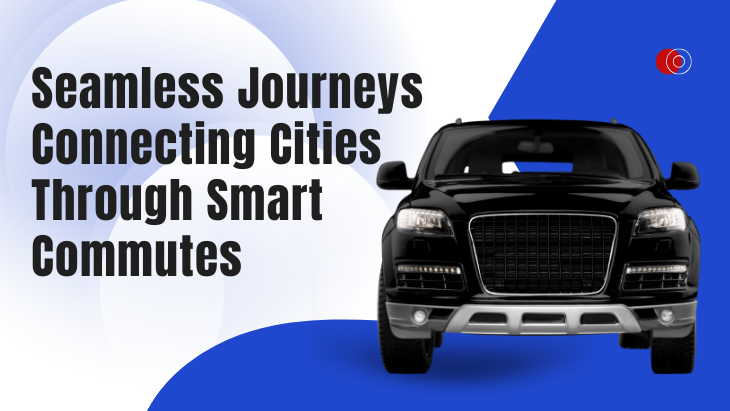Seamless Journeys Connecting Cities Through Smart Commutes

Posted on: 8 May, 2025
City life is evolving at a fast pace, and perhaps one of the most visible changes is in how we travel. Gone are the days when commuting was synonymous with getting stuck in traffic for hours or relying on inefficient public transport. Now, smart commuting technologies are revolutionizing how we travel within cities, with faster, safer, and more convenient options. At the center of this revolution is a unifying aim: making your daily commute simpler. Simplifying Your Daily Commute If you're a student, an office worker, or simply someone who wants to travel more efficiently, smart commute solutions are making journeys seamless, linking cities in ways never previously imagined.
What Is a "Smart" Commute?
Smart commutes use technology, information, and connectivity to enhance travel. It's about leveraging live traffic updates, ride-sharing apps, connected public transport apps, and GPS-based navigation to make each element of your journey seamless. From route optimization and live alerts to mobile ticketing, the commute has been made less stressful and more efficient. The technologies are meant to make your daily commute easier while lowering the carbon footprint and improving the urban experience. Through automating and customizing how we get around, smart commutes are opening the door to a more integrated and sustainable urban future.
From Chaos to Coordination: The Power of Data
Underlying seamless urban travel is the power of data. Each time a car moves or a rider opens a transit app, data is gathered to make the system better. Smart commute platforms leverage this information to determine traffic trends, streamline bus routes, and minimize waiting times. When such real-time information is exchanged over networks, cities become better coordinated. Such integration prevents congestion, minimizes emissions, and maximizes the reliability of transport means, eventually making your daily commute easier in ways that were previously unimaginable.
The Role of Ride-Sharing in Urban Connectivity
Ride-sharing is one of the most revolutionary elements of the smart commute system. Companies such as Trip-Tie are filling the gaps between mass transit and individual mobility, providing affordable and flexible travel. Shared rides cut down on traffic congestion, decrease carbon footprints, and enable cost-splitting. With AI-optimized route matching and intuitive apps, ride-sharing isn't just convenient it promotes city-wide connectivity. Such platforms enable people to travel from point A to B without the need for owning a car, making it more inclusive and environmentally friendly.
Multimodal Travel: A Commute That Fits Your Lifestyle
Today's commuters no longer depend on one mode of transportation. They may ride a bicycle to the railway station, go by subway, and cover the last mile using a scooter or ride-hailing. Intelligent commuting accommodates this with multimodal integration. Mobile apps now enable users to organize trips by different modes of transport in one convenient itinerary. You can view in real time how to best coordinate a bus ride with a bike share or walk to a pickup point for a ride-hailing service. This degree of coordination greatly streamlines your daily commute and provides a smoother, quicker ride through the urban terrain.
Reducing Stress, One Ride at a Time
A smart commute doesn’t just save time; it also reduces stress. Real-time updates about delays or changes in routes help commuters plan ahead, avoiding last-minute surprises. Notifications about the best times to travel or less crowded routes improve overall comfort and safety. No more second-guessing whether you'll miss a meeting due to traffic or a late train. With intelligent apps and digital tools leading the way, commuting is more predictable and less stressful. The outcome is a smoother, more stress-free beginning and end to your day.
Environmental Benefits of Smart Commuting
Smart commuting is not just good for you; it's good for the environment. By promoting carpooling, combining public transit, and streamlining traffic flow, these solutions lower greenhouse gas emissions and reduce fuel usage. Numerous cities are also integrating electric vehicles and public micro-mobility solutions such as e-scooters and e-bikes into their infrastructures. Such green alternatives promote cleaner air and healthier cities. Therefore, while you're streamlining your regular commute, you're also contributing to a cleaner tomorrow.
Enabling Cities with Innovation
Cities and governments now collaborate with tech firms to implement smart transportation infrastructure that links citizens, services, and infrastructure. Urban centers like Singapore, Amsterdam, and Seoul are already leading the way in adopting smart mobility strategies. These cities serve as models for how innovation can be used to enhance connectivity, reduce congestion, and improve quality of life.
Personalized Commuting for Modern Lifestyles
Customization is one of the principal advantages of smart commutes as well. Programs can now figure out your patterns of where you go, when you go, and how you want to get there and provide individualized recommendations. Don't want to hit traffic on the drive home? Get to a 9 a.m. meeting quickly? Your commute app's got your back. By providing an experience that is customized, these solutions make transit more intuitive and user-focused. This level of customer specificity further streamlines your daily journey to reduce the effort required, making your travels as comfortable and efficient as possible.
The Future of Seamless Travels
In the future, we are working towards even greater innovations in smart commuting. From autonomous buses and AI-powered public transportation to payment systems that allow you to pay for everything from cars to subways in a single tap, the future is all about seamless city-wide mobility. As technology advances, the vision of networked cities where each trip is seamless, quick, and green becomes increasingly real. For city residents, this translates to more time, less stress, and improved quality of life.
Conclusion
Smart commuting is not just a fad; it's a revolution. By integrating data, technology, and people-centered design, it's transforming the way we move around cities into faster, simpler, and greener travel. Trip-Tie Whether you're commuting through a crowded city or a developing city suburb, the technology to streamline your daily journey is already here. Adopt these innovations, and see how effortless journeys are not only linking cities; they're changing lives.


